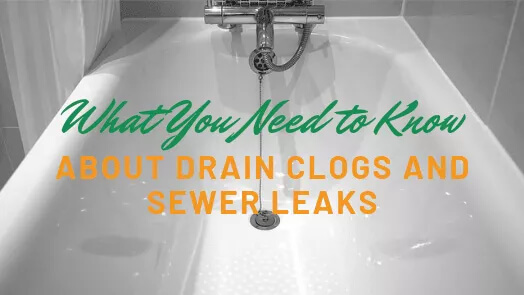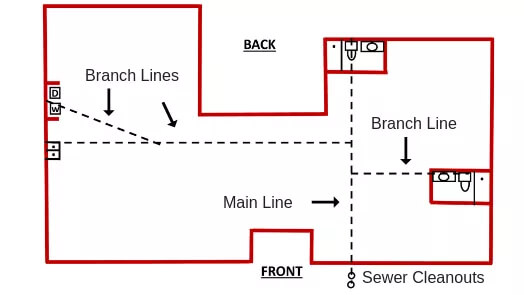
A sewer problem is a sewer problem is a sewer problem. Right?
Not really.
I’ve talked in depth on the blog about cast iron sewer pipes and whether or not you should repair or replace them. But today I want to talk about the differences between a clog and a leak.
You can have a clog. You can have a leak. You can also have a clog and a leak at the same time. But they are two different problems requiring different testing methods and different ways to fix them.
What Is a Drain Clog?
Clogs are also often called stoppages or backups. But whether you or a plumber call it a clog or a stoppage or a backup, it’s all means the same thing — your sewer system is not working properly. It’s not working as it was designed to work.
Sewer systems are installed at a slight decline. Water and debris then drain through and out of the your home’s system using the power of gravity.
Whether it’s a sink, a toilet, or a washing machine, water and debris are meant to flow through your home’s sewer system out to the city’s line. So if something is preventing that from happening, it’s possible you have a clog.
And you can tell a lot just by what is stopped up to determine to where the stoppage is.
P-traps
Let’s say you have a washing machine on the same side of the house as the kitchen and a bathroom on the opposite side of the house. All of these will have a line — a branch line — that attaches to a main sewer line that drains out of your house to the city’s sewer system at the street.

If water is backing up in a bathroom sink and no other fixtures are affected, I can almost guarantee you it’s just hair in the drain.
If you look under your bathroom or kitchen sink, you’ll find a P-trap which is designed to trap things like hair, food and other debris from draining too far into the sewer system. So you most likely have something stuck in the P-trap preventing that single fixture from draining.

P-traps are also located under tubs, showers and toilets. Another purpose for the P-trap is to prevent potentially dangerous sewer gas from escaping into your home.
However, if water is backing up in the tub and the sink but no other fixtures in the house, the clog is most likely somewhere on the branch line that attaches to the main line and not the P-traps.
Stoppages in the underslab pipes
If everything in the house is stopped up, you run the bathroom sink and it backs up into the tub (which is the lowest spot in the house). And when running the washing machine water backs up into the tub. This means the stoppage is most likely on the main line somewhere after where the other lines tie into it.
We then look at the cleanouts which are located outside of the house. If there’s no water in the cleanouts, we know the stoppage is somewhere in the main line under the house.
If there is water in the cleanouts, the stoppage is between the cleanouts and the city’s line. If you call the city and there’s no problem with their line, then we know the stoppage is somewhere between where your line ends at the street and the cleanouts — somewhere in your yard.
So as you can see, oftentimes we can use the power of elimination to figure out where a stoppage is located. A sewer camera is also something we can use to find a clog or drainage problem.
How To Fix a Drain Clog
To fix a stoppage that is caused by debris stuck in the line, we use a sewer machine.

These come in all kinds of different sizes and shapes. For a P-trap, we would use a small sewer machine. For a stoppage in the main line, a larger one.
Of course, some backups occur because of tree roots or a sagging line which require a more involved repair or possibly a replacement. But for our purposes today, we’ll stick with a regular clog or stoppage that can be cleared with a sewer machine.
What About Sewer Leaks?
A sewer leak is water escaping the pipe into the surrounding soil. Depending on how big the leak is, you can go years without knowing there is a leak in the line.
Finding a sewer leak, though, is a bit more involved than a clog. Despite other plumbing companies claiming they can, a sewer camera inspection CANNOT find or locate leaks.
For sewer leaks, we use inflatable test balls to determine first, if you have a leak and second, to locate them.
A Leak and a Stoppage?
As I mentioned earlier, you can have both a leak and a stoppage on the same line at the same time.
But generally, the water building up from the stoppage will escape out of the leak and you won’t know you have either problem. At least not right away.
Only when enough water has built up outside of the pipes that the soil underneath the slab cannot hold any more water. At that point, water would start to backup and you’ll start seeing signs of a stoppage.
In some cases, mud could get back in the line because of a leak causing a stoppage problem which is a different issue than the line not draining properly. This is the leak causing the draining issues which is a completely different problem than a pipe with a stoppage and a leak.
However, the most important thing to know and the point I want to make today is that even if you have a leak and a stoppage (for whatever reason) at the same time, these are two separate issues and must be addressed two different ways.
If you have any questions about drain clogs and sewer leaks, give us a call at 972-494-1750. You can also email us at service@inhouseplumbingcompany.com.

